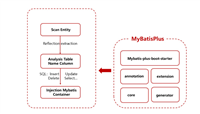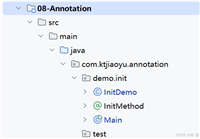1. mybatis n+1 问题详解
1.1 什么是n+1问题
n+1问题是指执行1次主查询获取n条主记录,然后对每条主记录再执行1次关联查询,总共执行 1 + n 次查询的性能问题。
1.2 示例场景
假设有:部门表(department)和员工表(employee),一个部门有多个员工。
产生n+1问题的代码如下:
<!-- 1. 先查询所有部门 -->
<select id="selectalldepartments" resultmap="departmentresultmap">
select id, name from department
</select>
<!-- 2. 为每个部门查询员工 -->
<select id="selectemployeesbydeptid" resulttype="employee">
select id, name from employee where dept_id = #{deptid}
</select>
<!-- 3. 结果映射中使用嵌套查询 -->
<resultmap id="departmentresultmap" type="department">
<id property="id" column="id"/>
<result property="name" column="name"/>
<collection property="employees" column="id"
oftype="employee" select="selectemployeesbydeptid"/>
</resultmap>
执行过程:
list<department> departments = departmentmapper.selectalldepartments(); // 实际执行的sql: // 1. select id, name from department; (假设返回3个部门) // 2. select id, name from employee where dept_id = 1; // 3. select id, name from employee where dept_id = 2; // 4. select id, name from employee where dept_id = 3; // 总共执行了 1 + 3 = 4 次查询
1.3 产生问题
- 性能低下:查询次数随数据量线性增长
- 数据库压力大:频繁建立数据库连接
- 响应时间长:网络往返次数多
接下来讲解解决1+n问题的方式
2. 使用join 查询 + collection 映射
2.1 实体类定义
// 部门实体
@getter
@setter
public class department {
private long id;
private string name;
private list<employee> employees; // 一对多关系
}
// 员工实体
@getter
@setter
public class employee {
private long id;
private string name;
private string position;
private long deptid;
}
2.2 xml配置
由于 join 查询有些情况会产生重复的部门数据,mybatis 会自动处理这种重复,但需要使用<id>标签指定好主键:
<!-- 使用 join 查询一次性获取所有数据 -->
<resultmap id="departmentwithemployeesmap" type="department">
<id property="id" column="dept_id"/><!-- 重要配置 -->
<result property="name" column="dept_name"/>
<!-- 使用 collection 映射一对多关系 -->
<collection property="employees" oftype="employee" javatype="java.util.arraylist">
<id property="id" column="emp_id"/><!-- 重要配置 -->
<result property="name" column="emp_name"/>
<result property="position" column="position"/>
<result property="deptid" column="dept_id"/>
</collection>
</resultmap>
<select id="selectdepartmentwithemployees" resultmap="departmentwithemployeesmap">
select
d.id as dept_id,
d.name as dept_name,
e.id as emp_id,
e.name as emp_name,
e.position,
e.dept_id
from department d
left join employee e on d.id = e.dept_id
where d.id = #{id}
</select>
<!-- 查询多个部门及其员工 -->
<select id="selectalldepartmentswithemployees" resultmap="departmentwithemployeesmap">
select
d.id as dept_id,
d.name as dept_name,
e.id as emp_id,
e.name as emp_name,
e.position,
e.dept_id
from department d
left join employee e on d.id = e.dept_id
order by d.id, e.id
</select>
2.3 使用实例
@service
public class departmentservice {
@autowired
private departmentmapper departmentmapper;
// 一次性获取部门及其所有员工,避免n+1问题
public department getdepartmentwithemployees(long deptid) {
return departmentmapper.selectdepartmentwithemployees(deptid);
}
// 获取所有部门及其员工
public list<department> getalldepartmentswithemployees() {
return departmentmapper.selectalldepartmentswithemployees();
}
// 业务方法:统计各部门员工数量
public map<string, integer> getemployeecountbydepartment() {
list<department> departments = departmentmapper.selectalldepartmentswithemployees();
return departments.stream()
.collect(collectors.tomap(
department::getname,
dept -> dept.getemployees() != null ? dept.getemployees().size() : 0
));
}
}
2.4 复杂场景(多层嵌套)
假设有一个多层嵌套的复杂场景,表关系如下:
// 公司实体
public class company {
private long id;
private string name;
private list<department> departments; // 一对多:公司有多个部门
}
// 部门实体
public class department {
private long id;
private string name;
private long companyid; // 所属公司id
private list<employee> employees; // 一对多:部门有多个员工
private list<project> projects; // 一对多:部门有多个项目
}
// 员工实体
public class employee {
private long id;
private string name;
private string position; // 新增字段
private long deptid; // 所属部门id
private list<skill> skills; // 多对多:员工有多个技能
}
// 项目实体
public class project {
private long id;
private string name;
private long deptid; // 所属部门id
private date startdate; // 新增字段
private date enddate; // 新增字段
}
// 技能实体
public class skill {
private long id;
private string name;
private string category; // 新增字段:技能分类
}
// 员工技能关联实体(多对多中间表)
public class employeeskill {
private long id;
private long employeeid;
private long skillid;
private integer proficiency; // 熟练程度
}
对应的mapper映射如下:
<!-- 更新后的结果映射,包含所有字段 -->
<resultmap id="companyresultmap" type="company">
<id property="id" column="company_id"/>
<result property="name" column="company_name"/>
<collection property="departments" oftype="department" resultmap="departmentresultmap"/>
</resultmap>
<resultmap id="departmentresultmap" type="department">
<id property="id" column="dept_id"/>
<result property="name" column="dept_name"/>
<result property="companyid" column="company_id"/>
<collection property="employees" oftype="employee" resultmap="employeeresultmap"/>
<collection property="projects" oftype="project" resultmap="projectresultmap"/>
</resultmap>
<resultmap id="employeeresultmap" type="employee">
<id property="id" column="emp_id"/>
<result property="name" column="emp_name"/>
<result property="position" column="position"/>
<result property="deptid" column="dept_id"/>
<collection property="skills" oftype="skill" resultmap="skillresultmap"/>
</resultmap>
<resultmap id="projectresultmap" type="project">
<id property="id" column="project_id"/>
<result property="name" column="project_name"/>
<result property="deptid" column="dept_id"/>
<result property="startdate" column="start_date"/>
<result property="enddate" column="end_date"/>
</resultmap>
<resultmap id="skillresultmap" type="skill">
<id property="id" column="skill_id"/>
<result property="name" column="skill_name"/>
<result property="category" column="category"/>
</resultmap>
<!-- 更新后的查询sql,包含所有字段 -->
<select id="selectcompanywithdetails" resultmap="companyresultmap">
select
c.id as company_id,
c.name as company_name,
d.id as dept_id,
d.name as dept_name,
d.company_id,
e.id as emp_id,
e.name as emp_name,
e.position,
e.dept_id,
p.id as project_id,
p.name as project_name,
p.dept_id,
p.start_date,
p.end_date,
s.id as skill_id,
s.name as skill_name,
s.category
from company c
left join department d on c.id = d.company_id
left join employee e on d.id = e.dept_id
left join project p on d.id = p.dept_id
left join employee_skill es on e.id = es.employee_id
left join skill s on es.skill_id = s.id
where c.id = #{id}
</select>
3. 分次查询+stream处理
还有一种方式是通过分次(次数为关联表的个数)查询关联表后,再使用stream流组装数据,下面是通过分次查询+stream处理查询公司详情信息的方法:
@service
public class companyservice {
public company getcompanywithdetails(long companyid) {
// 1. 查询公司
company company = companymapper.selectbyid(companyid);
if (company == null) return null;
// 2. 查询部门
list<department> departments = departmentmapper.selectbycompanyid(companyid);
// 3. 查询员工(批量查询避免n+1)
list<long> deptids = departments.stream()
.map(department::getid)
.collect(collectors.tolist());
list<employee> employees = employeemapper.selectbydeptids(deptids);
// 4. 使用stream组装数据
map<long, list<employee>> employeemap = employees.stream()
.collect(collectors.groupingby(employee::getdeptid));
departments.foreach(dept ->
dept.setemployees(employeemap.getordefault(dept.getid(), new arraylist<>()))
);
company.setdepartments(departments);
return company;
}
}
4. 性能对比
同样的业务下(查询公司详情信息)他们的性能对比表如下:
| 方面 | join+collection | 分次查询+stream |
|---|---|---|
| 数据库查询次数 | 1次 | 3次 |
| 网络开销 | 低 | 中等 |
| 数据库压力 | 单次复杂查询 | 多次简单查询 |
| 内存占用 | 可能有重复数据 | 数据更紧凑 |
| 响应时间 | 稳定但可能较长 | 可能更快(并行查询) |
总结:建议在管理后台数据展示这样的小数据量场景使用join+collection方案,在api接口大数据量这样较大数据量使用分次查询+stream方案。
到此这篇关于mybatis一对多关系映射方式小结的文章就介绍到这了,更多相关mybatis一对多关系映射内容请搜索代码网以前的文章或继续浏览下面的相关文章希望大家以后多多支持代码网!







发表评论